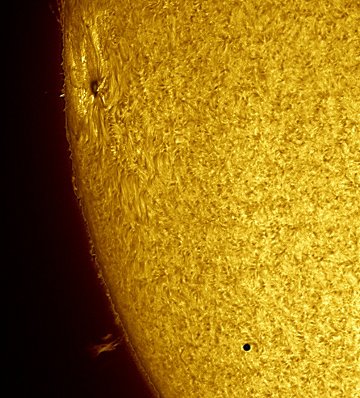 Did you sleep through the auroras of November? Next time get a wake-up call: Spaceweather PHONE.
Did you sleep through the auroras of November? Next time get a wake-up call: Spaceweather PHONE.
LUNAR LEONIDS: Meteoroids are hitting the Moon more often than anyone expected. That's the tentative conclusion of astronomers who recently saw two Leonids hit the Moon and explode. Get the full story from Science@NASA.
AND THE WINNER IS... Phillip Jones of Dallas, Texas. He won 1st place in the Transit of Mercury Photo Contest with this spectacular H-alpha image:

"I took the picture through a Coronado SolarMax90 set up at the University of Texas-Dallas campus," he says. "We displayed a live video feed of the transit on my laptop for students and faculty to see."
The Contest: Complete Results
SUNDOGS ON ICE: Looking for sundogs? Forget about the sky. The place to look is frozen lakes! Photographer Vesa Särkelä of Kemijärvi, Finland, entitles this picture Sundogs on Ice:

"Warm days and rain melted the snow on the ice of lake Kemijärvi," says Särkelä. "Then, on Nov. 28th, it froze again." The resulting crystaline structure of the lake's surface produced a luminous halo normally seen only among icy clouds in the sky.
"Halos need near perfect hexagonal ice crystals and sometimes these can be found on the ground or lakes after a thaw followed by a slow freeze," explains atmospheric optics expert Les Cowley. "When that happens we can see halos beneath the horizon. These are probably sub sundogs."

